Your Guide to Composting
Introduction
Composting, often referred to as nature’s recycling, is a powerful and accessible way to impact the environment while nurturing your garden positively. It’s a process that takes organic materials, such as kitchen scraps and yard waste, and transforms them into a nutrient-rich soil amendment known as compost – often referred to as “black gold” in gardening circles. This natural alchemy enriches your garden soil and contributes to a sustainable future by reducing waste and greenhouse gas emissions.
While some may associate composting with complexity, unpleasant odors, or heaps of mess, the truth is far more straightforward and rewarding. When done correctly, composting is an approachable and effective means of managing organic waste while nurturing your garden’s vitality. This comprehensive guide will debunk common misconceptions, outline the straightforward steps of successful composting, and emphasize how anyone can seamlessly integrate this eco-friendly practice into their lifestyle.
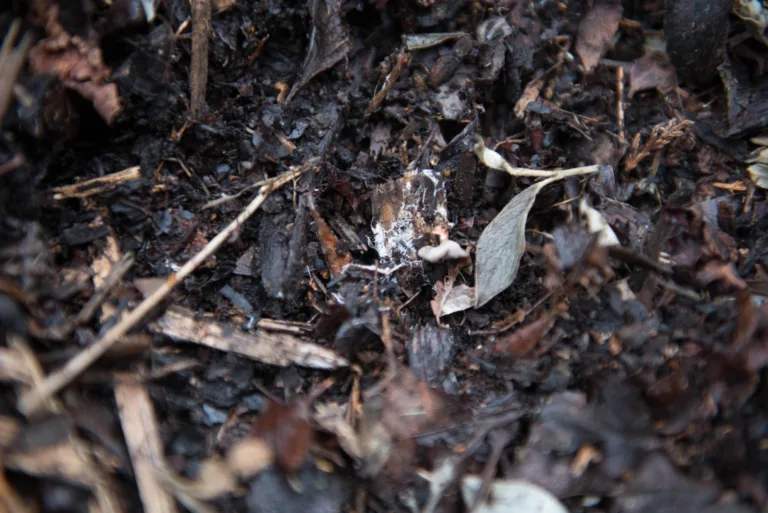
Environmental Benefits of Home Composting
Waste Reduction and Greenhouse Gas Emissions: One of the most compelling reasons to embrace home composting is its direct impact on waste reduction. When organic materials like food scraps and yard clippings end up in landfills, they decompose in an oxygen-deprived environment and produce methane, a potent greenhouse gas. By diverting organic waste from landfills, you’re minimizing the strain on these already burdened systems and preventing methane emissions.
As these materials decompose in your compost pile, they become nutrient-rich compost that enriches the soil, reducing the need for chemical fertilizers. Adding this to our reduction in greenhouse gas emissions, we create a win-win scenario for your garden and the environment. We’re just starting, and we can already see how easy it is to contribute to the greater fight against climate change.
Soil Enhancement and Plant Growth: The benefits of home composting extend to the heart of your garden: the soil. Compost is a natural soil conditioner with benefits extending deep beyond the surface. Not many beginner gardeners think of the structure of the soil; I know I didn’t! Compost is one of the best ways to improve your soil’s structure. This mixture creates a crumbly and porous texture, allowing for better aeration and root penetration. This improved soil structure also facilitates water retention, ensuring moisture is available to plants for extended periods. In regions like desert environments, where water is scarce, compost-amended soil becomes an invaluable resource in maintaining healthy gardens and landscapes.
Prevention of Soil Erosion and Promotion of Healthy Plant Growth: Erosion can degrade soil quality and lead to loss of fertile topsoil, affecting the health and productivity of plants. Compost acts as a natural erosion deterrent by binding soil particles together, reducing the risk of erosion caused by wind and water. As previously mentioned, the organic matter in compost also introduces essential nutrients to the soil, fostering robust plant growth and resilience. As you apply compost to your garden, you actively restore and preserve soil integrity. Whether you plant directly in the ground or garden beds, you’re fostering a thriving soil ecosystem that nurtures plant growth, enhances root development, and promotes overall plant health. This results in more bountiful harvests, vibrant blooms, and a lush landscape.
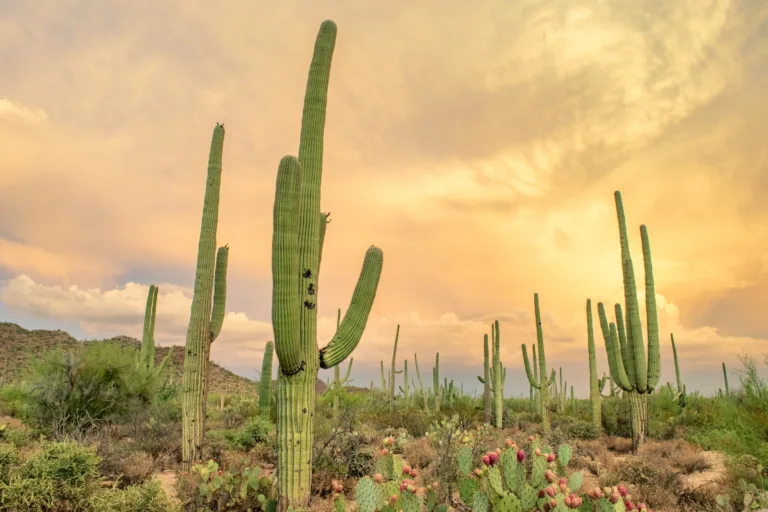
Contribute to the Local Ecosystem and Desert Greening Efforts: Composting in a local context, such as the desert environment here in Tucson, presents challenges and unique rewards. In these regions characterized by arid conditions, composting takes on an even more crucial role in conserving water. Compost-amended soil has the remarkable ability to retain moisture, reducing the need for frequent watering and supporting plant life in challenging climates.
Composting in a desert environment contributes to the restoration of soil health and creates a microcosm of sustainable growth amidst challenging conditions. The increased vegetation, in turn, helps stabilize dunes, prevent desertification, and provide habitats for wildlife. From native grasslands to trees and veggie gardens, these all help reduce ground heat as well! Your composting efforts become a testament to the resilience of nature and the power of individual action in creating a greener, more vibrant world.
As you embrace composting at home, remember that your actions have far-reaching effects. Beyond the immediate benefits of enriching your garden, you’re participating in a greater movement toward environmental stewardship. By reducing waste, conserving resources, and nurturing soil health, you’re actively shaping a more sustainable and harmonious future for your local community and the planet at large. In the following sections, we’ll delve into the practical aspects of creating and maintaining your compost pile, empowering you to make a meaningful difference through your composting journey.
Getting Started with Home Composting:
Embarking on your home composting journey is an exciting step toward sustainability and garden enhancement. With a few fundamental principles and some basic know-how, you can create a thriving compost pile right in your backyard. Let’s dive into the essentials of getting started with home composting.
Backyard Composting Explained: Backyard composting involves harnessing the natural process of decomposition to transform organic materials into nutrient-rich humus – a valuable soil amendment. Through controlled decay, you’ll create a dynamic ecosystem within your compost pile that includes a diverse community of microorganisms, insects, and other decomposers. These tiny helpers work together to break down your compostable materials and create the finished product: dark, crumbly compost that enriches the soil and promotes plant health.
Balancing Browns and Greens: A fundamental principle in successful composting is balancing “browns” and “greens.” Browns refer to carbon-rich materials such as dried leaves, straw, and newspaper, while greens encompass nitrogen-rich items like kitchen scraps, grass clippings, and coffee grounds. Maintaining a proper balance between these two categories ensures efficient decomposition and prevents common issues like foul odors or slow composting. Aim for a roughly equal mix of browns and greens to create the optimal environment for microbial activity.
Credit to Growit Buildit for the video, he definitely does a great job at explaining it.
The Role of Water, Oxygen, and Microorganisms: Three critical factors – water, oxygen, and microorganisms – drive the composting process. Adequate moisture is essential for microorganisms to thrive and break down organic matter. You want your compost pile to be as damp as a wrung-out sponge – not too wet or dry. Oxygen, on the other hand, facilitates aerobic decomposition, allowing beneficial bacteria to work efficiently. Regularly turning or aerating your compost pile introduces oxygen and prevents it from becoming compacted.
Essential Equipment and Setup: Creating a compost pile or bin in your yard doesn’t require elaborate equipment. You can start small with a simple pile or construct a compost bin using materials like wire mesh or wooden pallets. Choose a well-drained, level spot in your yard that receives partial sunlight. This location will help maintain the right temperature for decomposition while allowing excess moisture to drain. Place a layer of coarse materials like small sticks or straw at the bottom to improve airflow and drainage.
Once you have established your composting area, build your pile by layering browns and greens. To aid decomposition, periodically turn the mound with a pitchfork or compost turner to mix materials and introduce oxygen. As the composting process progresses, you’ll witness the transformation of your initial mix into nutrient-rich compost ready to enrich your garden.
Dos and Don’ts of Home Composting: Composting is a rewarding endeavor that empowers you to actively contribute to a more sustainable lifestyle while nurturing your garden. The key to a smooth and productive composting journey is to adhere to a few fundamental dos and avoid common pitfalls. Let’s explore the dos and don’ts of home composting to help you achieve composting success.
Acceptable “Greens” and “Browns” Materials
Greens: These nitrogen-rich materials provide the essential nutrients that fuel microbial activity in your compost pile. Acceptable greens include kitchen scraps like fruit and vegetable peels, coffee grounds, tea bags, and fresh plant trimmings. Grass clippings and livestock manure (from herbivores) are also excellent green additions. These materials introduce vital nitrogen to your compost, facilitating the breakdown of organic matter.
Browns: Carbon-rich browns create a balanced environment in your compost pile and help prevent odors. Suitable browns include dried leaves, straw, shredded newspaper, and cardboard. Woody materials such as small branches and wood chips also fall into this category. Browns provide the carbon necessary for structural support and the absorption of excess moisture.
Proper Balance: Achieving the right balance between greens and browns is paramount to successful composting. Too many greens can result in a smelly, slimy pile, while an excess of browns may lead to slow decomposition. As previously stated, aim for a roughly equal mix of these materials to create an environment that supports thriving microbial communities. Regularly turning or aerating your pile helps mix the materials, ensuring even decomposition and preventing unpleasant odors.


Items to Avoid Adding to the Compost Pile: While many organic materials can contribute to composting, there are some items you should not throw in your pile. Meat, dairy, and oily foods can attract pests and slow decomposition, so avoid tossing these in your pile. Pet waste, including cat litter and dog waste, should also be excluded due to potential health risks. Treated wood and materials treated with chemicals can introduce harmful substances into your compost, compromising its quality. Remember, a healthy compost pile is a balanced ecosystem, so stick to plant-based materials and avoid potential contaminants.
Troubleshooting Common Issues: Even the most seasoned composters encounter challenges from time to time. If your compost pile becomes overly wet, add more browns to absorb excess moisture. If it’s too dry and decomposition is sluggish, introduce additional greens and water. You can often mitigate pest problems by burying food scraps deep within the pile or using a layer of browns to cover exposed materials. Remember, composting is a dynamic process, and adjustments may be needed to maintain optimal conditions.
By adhering to these dos and don’ts, you’ll create an environment conducive to efficient composting and minimize potential setbacks. In the next section, we’ll delve into the art of maintaining your compost pile, ensuring it remains a thriving ecosystem that produces nutrient-rich compost for your garden.
Maintaining Your Pile:
Congratulations on embarking on your composting journey! Now that you’ve set up your compost pile, it’s time to dive into the art of maintaining it for optimal results. A well-maintained compost pile is the key to producing nutrient-rich compost that will enrich your garden and contribute to a healthier environment. Let’s explore the essential aspects of maintaining your compost pile.
Regular Turning for Aeration and Decomposition: Turning, or aerating, your compost pile is vital in maintaining a healthy composting environment. Regularly mixing the materials helps introduce oxygen, which is essential for the growth of aerobic microorganisms that break down organic matter. Using a pitchfork or compost turning tool, gently mix the contents of your pile. Aim to turn your pile every week or two, thoroughly combining the materials.
Monitoring and Adjusting Moisture Levels: Proper moisture is crucial for the success of your compost pile. A balance between wet and dry materials is necessary to facilitate decomposition. Check the moisture content regularly by squeezing a handful of the compost. It should feel like a damp sponge. If it’s too dry, add water; if too wet, incorporate more dry browns to absorb excess moisture.
Achieving Optimal Temperatures for Pathogen and Weed Seed Elimination: As your compost pile decomposes, it generates heat. Monitoring the internal temperature is essential, as it helps eliminate potential pathogens and weed seeds. Aim for a temperature range between 130°F and 150°F (54°C to 65°C) in the core of the pile. This heat also accelerates decomposition, allowing you to produce compost more efficiently.
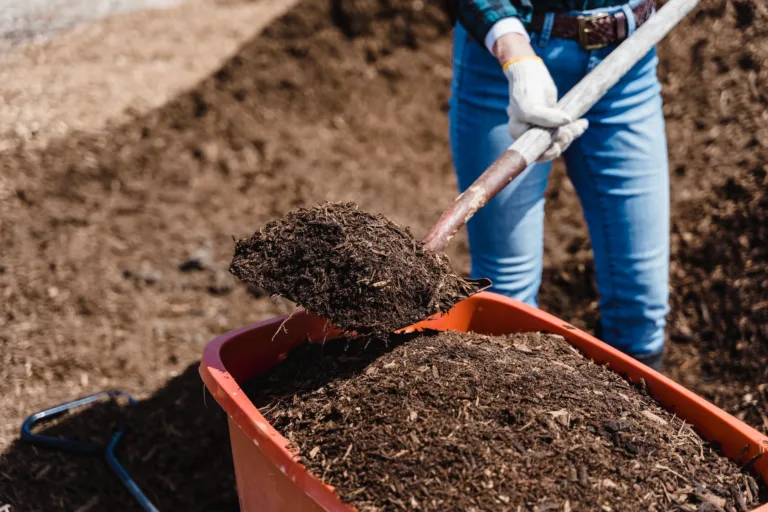
Regular maintenance extends beyond turning and monitoring moisture and temperature levels. As your pile matures, you may notice that it gradually reduces in size and transforms into dark, crumbly compost. At this point, you can sift the compost to separate any larger, undecomposed materials, which you can toss back into the pile for further breakdown. The mature compost is now ready to be used in the ground or your garden beds, providing valuable nutrients to your plants.
Exploring Different Composting Methods:
While the basic principles of composting remain the same, there are various methods you can explore to suit your preferences and circumstances. These include traditional backyard composting, vermiculture (composting with worms), and approaches using compost tumblers or compost bins. Each method offers its unique advantages and considerations, and finding the right fit for your lifestyle and available space is key to successful composting.
Composting in a bin offers controlled and compact decomposition, ideal for smaller spaces and urban environments, such as apartments. It provides a contained setting where organic materials break down efficiently, with less risk of pests or odor. On the other hand, composting in a pile offers a larger-scale option suitable for spacious areas. Piles require more space and effort to manage, offering greater airflow and quicker decomposition. While bins are tidy and manageable, piles excel in handling larger quantities of organic matter and may be a better fit for those with ample outdoor space and a desire for a more natural composting process. Choose the method that aligns with your space, lifestyle, and composting goals.
Composting and vermicomposting timelines vary, but both yield nutrient-rich soil amendments. Traditional composting typically takes several months to a year, resulting in a dark, crumbly mixture with a rich earthy scent (well-maintained piles can be finished in as little as a few weeks). Finished compost is ready when the original materials are unrecognizable, and the blend feels and smells like fertile soil. To use, mix it into garden beds or potting soil.
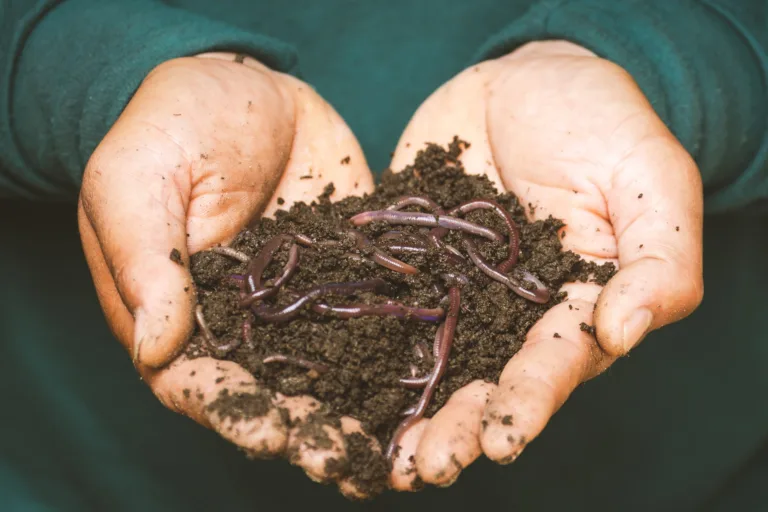
Understanding Vermicomposting: A Brief Overview
Vermicomposting harnesses the power of Red Wiggler worms (Eisenia fetida) to break down organic matter into a nutrient-rich substance known as vermicast, or worm castings. These hardworking worms consume kitchen scraps, fruit peels, coffee grounds, and other organic materials, transforming them into a valuable resource for enriching the soil and promoting plant growth.
Vermicomposting with red wiggler worms accelerates the process, often yielding finished vermicast in about 3-6 months. Vermicast is dark and granular, resembling coffee grounds, with a subtle, pleasant odor. Once the majority of the bedding is transformed, harvest the vermicast and apply it directly as a top dressing or mix it into your garden soil to boost plant health and growth.
In gardens, apply both compost and vermicast as a top layer, gently incorporating them into the upper soil. These nutrient-rich amendments enhance soil structure, water retention, and microbial activity, fostering healthier plant growth. As your garden flourishes with the benefits of composting and vermicomposting, you’ll enjoy vibrant blooms, bountiful harvests, and a greener, more sustainable landscape.
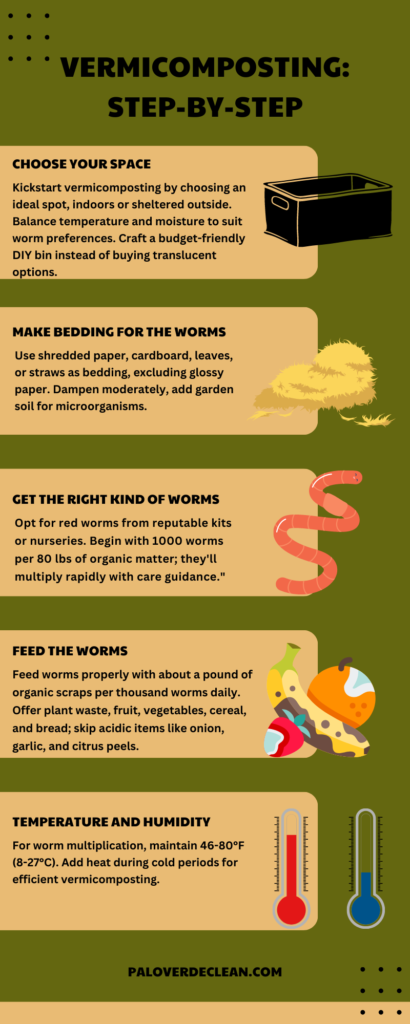
Conclusion
Start Today, Impact Tomorrow: The composting journey begins with simple steps—collecting kitchen scraps, blending “browns” and “greens,” and tending to your compost pile. As you witness the transformation of discarded materials into precious soil enhancers, the impact of your simple actions will inspire you! Each compost heap represents a commitment to a greener community and a healthier planet.
So, let this be your call to action. Start composting at home, and watch as your efforts ripple through the community, inspiring others to join the movement. As your garden flourishes and your soil teems with life, you’ll know you’re contributing to a more sustainable and resilient future. Together, we can turn waste into nourishment, arid land into thriving gardens, and individual actions into a collective force for positive change.
Join the movement today, and let your composting journey be the legacy you leave for generations. Together, we cultivate a world of vibrant life and sustainable practices, one compost pile at a time.
Need help composting?
Check out our composting and recycling implementation service!

